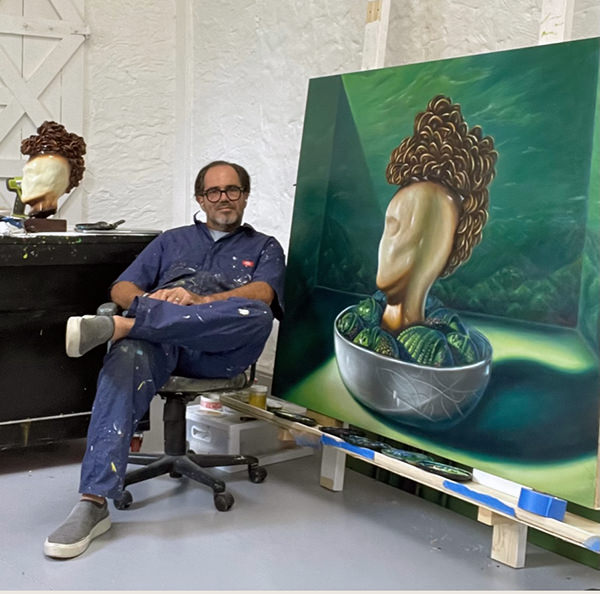My work is a playful invitation to consider serious questions.
This exhibition extends my ongoing conversation about our ecological and human fragility, anchored in a cognitive exploration, and a spiritual introspection. ; all this seen through the lens of the Still Life, wrapped in a theatrical magical realism.
My dialogue begins with the Surrealist Rene Magritte. Magritte’s synthesized tendency created a subtle and romantic lexicon that has guided my own practice since its inception. However, the guiding star to this Series has been the lineage of the Dutch Vanitas tradition of painting from the 17th century.
The Vanitas primarily evokes the stark truth of our mortality (memento mori), urging us to reflect on our life pursuits and daily practices. For Vanitas, the still-life speaks of the futility of our earthly pursuits in the face of our mortal existence. They invite the viewer to focus their mind on the is Holy and Divine through their interaction with what is on Earth.
The Dutch Protestant fostered a more individualistic approach to contemplation in comparison with the communal prayer of Catholics. This approach dismantles the religious structures and creates a sacred space within the canvas. This radical act transformed the paintings into temples
of contemplation, inviting dialogue with the Divine.
I align myself with these beliefs. Today, I see our cultural institutions as our contemporary temples of reason. They create the space for the questions of our time while embracing the courageous and ambiguous languages that will lead us to re-imagine our questions, our answers and ultimately, our world.
In this Series I introduce a new discipline : Ceramics. An important part of my process is the translation of a new, still clumsy ceramic practice into my paintings. It is in those liminal spaces where knowing and not knowing converge, and an unknown clarity seems to emerge. In the clay I find the fertile soil that gives life to these forms, (typically heads or vessels), which I reinterpret onto the canvas, where they are grounded on a stage or table, in an incase Landscape.
In these paintings I place the ceramic vessels or sculpture as both protagonists and collectors, narrating within their limits and their desire to break out of them. The heads speak of mental constructs, our disembodied approach, our disconnection from the natural world and even from our bodies. The black box Still Life, serves as a symbol of us, of the human theater, of our limitations and our impermanence. As in the Vanitas, one of my constants is foliage (in my case, tropical plants, my native flora). Another constant is the vessel, which has infinite meanings, but, for me, hearkens to my migration.
Still life for me is a way to integrate the language of Nature. I place my subjects as objects in the still life of Nature. I invite them to listen to the ancient whispers carried by the wind to the trees, to the gentle dances between the rocks and the rain. It is a slow conversation that sings of our beginnings and of our destination. It says “Let us not merely inhabit Nature; let us recognize that we “are” Nature!”
This realization, like a slow, melodic song, has the power to bring silence….. It beckons us toward an indigenous tradition of reciprocity—a culture of giving back.
It invites us to consider: How can we aid this delicate ecosystem in its restoration and replenishment? It guides us in learning to become aware of the sentience
of other beings . It guides us back to Nature but from a higher understanding.
The act of painting is my reciprocity, by mimicking Nature’s hues and rhythms. These hues have guided our evolution, shaping our path
through time. Just as flowers bloom in vibrant colors to attract pollinators and spread their seeds, I seek to captivate the viewer’s gaze and propagate these ideas. My hope is to sow seeds of reverence and spread the gospel of love for the natural world.
Painting is a language of Silence; The Dutch Masters understood this well. Their canvases became contemplative spaces where one listens in a non-auditory way. It’s a dialogue with the self, a communion with the body’s wisdom, a trust in spirit and intuition. Here, we can travel to a language beyond the confines of what we understand to be us.
My work is an invitation to reflect, to pause, to listen to the whispers of existence…. In essence, my ceramic and painting practice is a series of self-portraits. It is a reflection of my past, my present, and my hopes for the future. It is a dialogue with Nature, a call for reciprocity, and a celebration of our shared existence. It is a self-portrait of me, us, trying to make sense of this world. It is a self-portrait of us as Nature.

